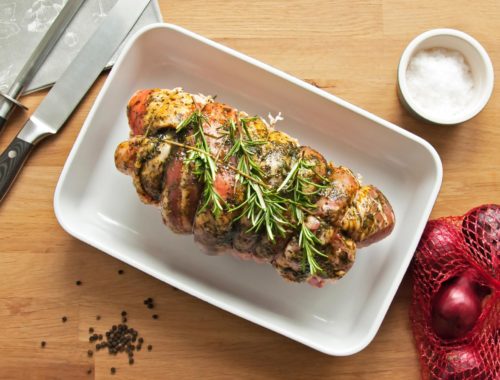What is Carryover Cooking?
We’ve all had it happen… we’re preparing a special, or even not-so-special, meal of ___________ (fill in the blank – T-bone, NY Strip, Ribeye, Beef or Pork Tenderloin, Pork Loin or Prime Rib). We’ve seasoned it just right with fresh herbs and delightful spices. It is beautifully enticing even before it is roasted or grilled!
We carefully monitor the internal temperature and after the appropriate amount of time, we see a wonderfully golden-brown masterpiece, the kitchen if filled with intoxicating aromas and it’s time to enjoy our _______ (T-bone, Ribeye, Beef or Pork Tenderloin, Pork Loin or Prime Rib)! Before slicing it for the serving platter, we allow it to rest while completing the final side dish prep.
Then, it happens. Oh, how our excitement is immediately dashed! Our masterpiece is visibly well overcooked! How could this happen? One likely culprit is “carryover cooking”.
What is Carryover Cooking and How Can We Use it to Our Advantage?
When meat is cooked using a stovetop, oven, or grill, heat energy is generated on the exterior then works its way inward – cooking from the outside, in, aka “conduction”. For a period of time after the meat is removed from the heat, that energy continues to move inward cooking the cooler center even though it is no longer on the heat source. This is “carryover cooking”.
Carryover cooking time varies but generally lasts anywhere from 5 – 20 minutes, raising the internal temperature by about 10 – 20 degrees which can make a big difference in the outcome of that roast or steak. This is why it is commonly recommended to remove meat from the heat source when it reaches an internal temperature of about 10 degrees lower than its target temperature and allow it to “rest” before slicing and serving while the juices redistribute.
For example, if you enjoy a steak cooked to medium-rare (internal temperature
of 130 – 135 degrees), it is advised to remove it from the heat source when the
internal temperature reaches 120 – 125 degrees. Over the next 3 – 5 minutes while
you turn off the grill, oven or stovetop, gather those who are dining, and bring the rest
of the dinner items to the table, the steak is “resting” and will continue to cook inside,
raising that internal temperature by about 10 degrees.
The thickness or size of the piece of meat and the cooking temperature affect carryover cooking.
- Larger or thicker pieces of meat will have longer carryover cooking times and higher temperature increases. Thinner pieces require less time to reach the proper internal temperature.
- High heat cooking generally has longer carryover cooking times because more energy is generated and moving toward the center.
- Slow-cooked foods at low temperatures do not require a resting period because the energy is more evenly distributed throughout the cooking process. Carryover cooking temperature increases may only be a few degrees.
COOKING GUIDE
Thanks to Cooks Illustrated for posting this handy guide for determining when to remove meat from its heat source. (Cooks Illustrated – “All About Carry Over Cooking”)
|
Use our guidelines to determine exactly when to take meat off the heat so when you serve it, it’s at the desired temperature. (Note: While carryover cooking can occur in poultry, for food safety reasons we usually don’t recommend removing it from the heat until it’s done.) |
|||
|
For Final Serving Temp |
STOP Cooking When Temperature Reaches |
||
| BEEF and LAMB | Larger Roasts / High Heat | Thin Cuts / Moderate Heat | |
| · Rare | 125°F | 115°F | 120°F |
| · Medium-Rare | 130°F | 120°F | 125°F |
| · Medium | 140°F | 130°F | 135°F |
| · Well Done | 160°F | 150°F | 155°F |
| PORK | |||
| · Medium | 150°F | 140°F | 145°F |
| · Well Done | 160°F | 150°F | 155°F |
TIP: USE A GOOD QUALITY THERMOMETER
It’s important to have a good quality digital instant-read meat thermometer for checking the internal temperature. As I listed in last month’s post, I recommend Thermopop by ThermoWorks. To learn more about selecting and using a meat thermometer, check out –
- Cooks Illustrated Equipment Review – Digital Instant-Read Thermometers.
- “The Right Way to Use a Meat Thermometer” from Serious Eats.
- “Using a Meat Thermometer” by Better Homes and Gardens
- “How to Calibrate Your Meat Thermometer” by the Kitchn
© 2019 Love + Craft Kitchen, LLC, All Rights Reserved
Main photo: Mike Tinnion on Unsplash


Recent Comments